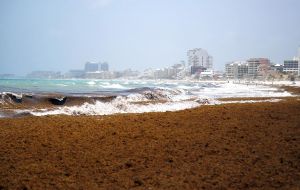MercoPress. South Atlantic News Agency
Sargassum bloom are ruining Caribbean beaches and tourism season
 The seaweed invasion has hit Caribbean shorelines so severely that some tourists have cancelled summer trips and locals call it a “natural disaster.” (Pic Reuters)
The seaweed invasion has hit Caribbean shorelines so severely that some tourists have cancelled summer trips and locals call it a “natural disaster.” (Pic Reuters)  The stinking mounds of seaweed in some cases have piled up nearly three meters high on beaches, choked scenic coves and cut off moored boats.
The stinking mounds of seaweed in some cases have piled up nearly three meters high on beaches, choked scenic coves and cut off moored boats.  Caricom is considering an emergency meeting worried that the seaweed influx could become a chronic dilemma for the globe's most tourism-dependent region.
Caricom is considering an emergency meeting worried that the seaweed influx could become a chronic dilemma for the globe's most tourism-dependent region. The picture-perfect beaches and turquoise waters that people expect on their visits to the Caribbean are increasingly being fouled by mats of decaying seaweed that attract biting sand fleas and smell like rotten eggs.
Clumps of the brownish seaweed known as sargassum have long washed up on Caribbean coastlines, but researchers say the algae blooms have exploded in extent and frequency in recent years. The 2015 seaweed invasion appears to be a bumper crop, with a number of shorelines so severely hit that some tourists have cancelled summer trips and lawmakers on Tobago have termed it a “natural disaster.”
From the Dominican Republic in the north, to Barbados in the east, and Mexico's Caribbean resorts to the west, officials are authorising emergency money to fund cleanup efforts and clear stinking mounds of seaweed that in some cases have piled up nearly 10 feet high on beaches, choked scenic coves and cut off moored boats.
With the start of the region's high tourism season a few months away, some officials are calling for an emergency meeting of the 15-nation Caribbean Community, worried that the worsening seaweed influx could become a chronic dilemma for the globe's most tourism-dependent region.
“This has been the worst year we've seen so far. We really need to have a regional effort on this because this unsightly seaweed could end up affecting the image of the Caribbean,” said Christopher James, chairman of the Tobago Hotel and Tourism Association.
There are various ideas about what is causing the seaweed boom that scientists say started in 2011, including warming ocean temperatures and changes in the ocean currents due to climate change. Some researchers believe it is primarily due to increased land-based nutrients and pollutants washing into the water, including nitrogen-heavy fertilisers and sewage waste that fuel the blooms.
Brian Lapointe, a sargassum expert at Florida Atlantic University, says that while the sargassum washing up in normal amounts has long been good for the Caribbean, severe influxes like those seen lately are ``harmful algal blooms“ because they can cause fish kills, beach fouling, tourism losses and even coastal dead zones.
”Considering that these events have been happening since 2011, this could be the 'new normal.' Time will tell,” Lapointe said.
The mats of drifting sargassum covered with berry-like sacs have become so numerous in the Caribbean Sea and the Atlantic Ocean they are even drifting as far away as to West Africa, where they've been piling up fast in Sierre Leone and Ghana.
Sargassum, which gets its name from the Portuguese word for grape, is a floating brownish algae that generally blooms in the Sargasso Sea, a 2 million-square-mile (3 million-square-kilometer) body of warm water in the North Atlantic that is a major habitat and nursery for numerous marine species. Like coral reefs, the algae mats are critical habitats and mahi-mahi, tuna, billfish, eels, shrimp, crabs and sea turtles all use the algae to spawn, feed or hide from predators.
But some scientists believe the sargassum besieging a growing number of beaches may actually be due to blooms in the Atlantic's equatorial region, perhaps because of a high flow of nutrients from South America's Amazon and Orinoco Rivers mixing with warmer ocean temperatures.
“We think this is an ongoing equatorial regional event and our research has found no direct connection with the Sargasso Sea,” said Jim Franks, senior research scientist at the University of Southern Mississippi's Gulf Coast Research Laboratory




Top Comments
Disclaimer & comment rules-

-

-

Read all commentsIf nothing else, they could try to harvest this stuff and produce organic fertilizer for export.
Aug 12th, 2015 - 04:57 pm 0“ Some researchers believe it is primarily due to increased land-based nutrients and pollutants washing into the water, including nitrogen-heavy fertilisers and sewage waste that fuel the blooms.”...
Aug 12th, 2015 - 07:36 pm 0Sewage waste ?? sounds about right ...
“... fouled by mats of decaying seaweed that attract biting sand fleas and smell like rotten eggs.”
Aug 12th, 2015 - 08:23 pm 0and yet, even in that condition, they are 1.000.000.000 % better than the islets, which are covered with guano and sheep-droppings and smell like shite.
Commenting for this story is now closed.
If you have a Facebook account, become a fan and comment on our Facebook Page!